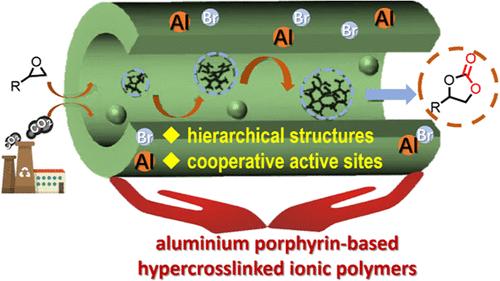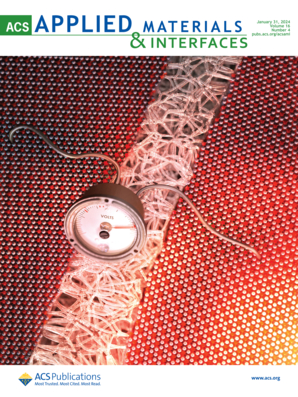Boosting CO2 Catalytic Fixation to Cyclic Carbonates over Aluminum Porphyrin-Based Porous Hyper-Cross-Linked Ionic Polymers via Synthetic Control of Active Site Proximity
IF 8.3
2区 材料科学
Q1 MATERIALS SCIENCE, MULTIDISCIPLINARY
引用次数: 0
Abstract
Multifunctionalization of porous organic polymers (POPs) toward cooperative CO2 catalysis has attracted so much attention in recent years, but it still remains a huge challenge to scientists. In this contribution, a concise and efficient method to construct aluminum porphyrin-based hyper-cross-linked ionic polymers has been demonstrated for the first time, which are featured with high surface areas and hierarchical structures. Obviously, the preparation of metalloporphyrin-based hyper-cross-linked polymers with tetraphenylmethane-derived three-dimensional structures is beneficial for the introduction of abundant ionic active sites and the formation of hierarchical porous structures. By regulating the locations and amounts of cooperative active sites to make them highly dispersed and easily accessible, the catalytic activity of as-maded catalyst can be greatly improved for CO2 cycloaddition conversion to cyclic carbonates without cocatalysts and solvents, providing the highest initial turnover frequency up to 8400 h–1 of heterogeneous catalysts reported to date. In addition, the catalyst can be easily recovered by filtration and reused at least ten times without a significant decrease in catalytic activity. This work not only presents a promising strategy to improve the catalytic activity by controlling active site proximity via different synthetic methods but also offers an attractive perspective in the field of CO2 catalytic conversion.

求助全文
约1分钟内获得全文
求助全文
来源期刊

ACS Applied Materials & Interfaces
工程技术-材料科学:综合
CiteScore
16.00
自引率
6.30%
发文量
4978
审稿时长
1.8 months
期刊介绍:
ACS Applied Materials & Interfaces is a leading interdisciplinary journal that brings together chemists, engineers, physicists, and biologists to explore the development and utilization of newly-discovered materials and interfacial processes for specific applications. Our journal has experienced remarkable growth since its establishment in 2009, both in terms of the number of articles published and the impact of the research showcased. We are proud to foster a truly global community, with the majority of published articles originating from outside the United States, reflecting the rapid growth of applied research worldwide.
 求助内容:
求助内容: 应助结果提醒方式:
应助结果提醒方式:


